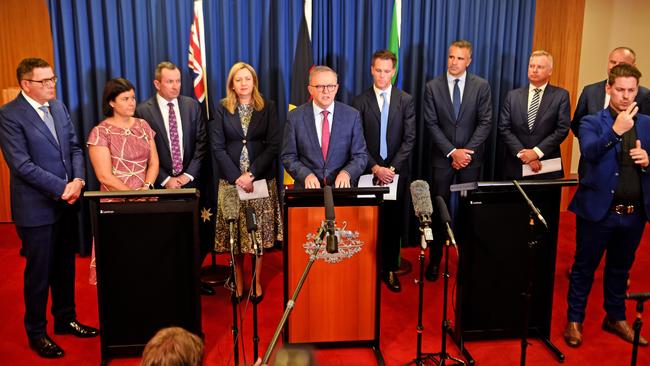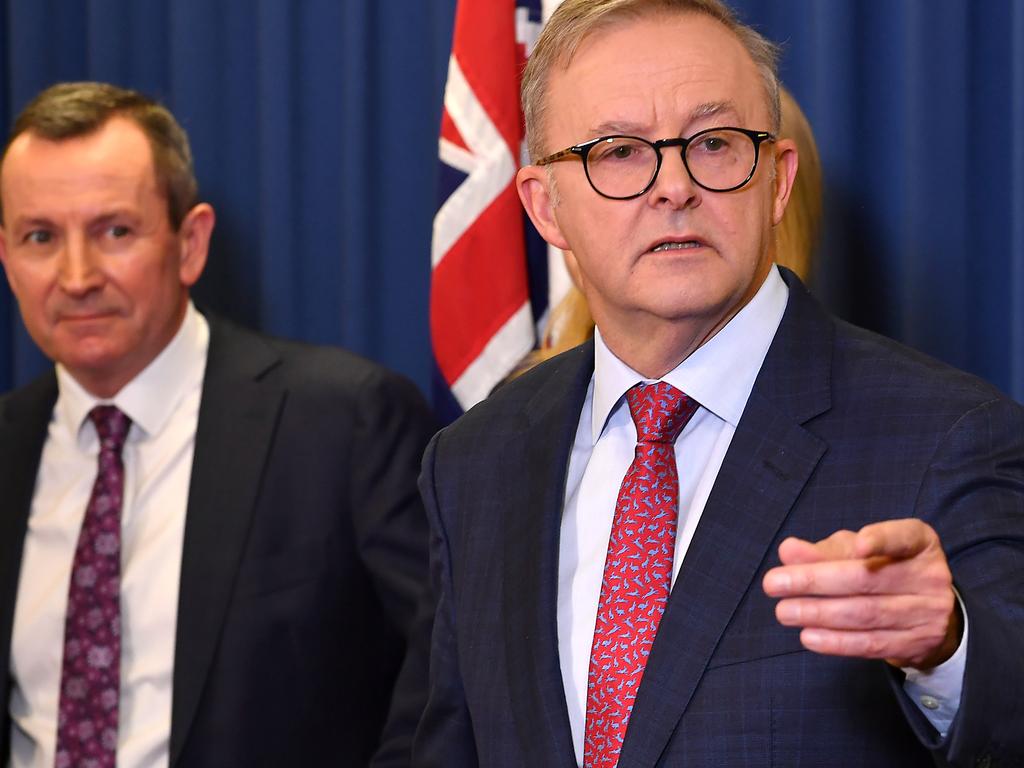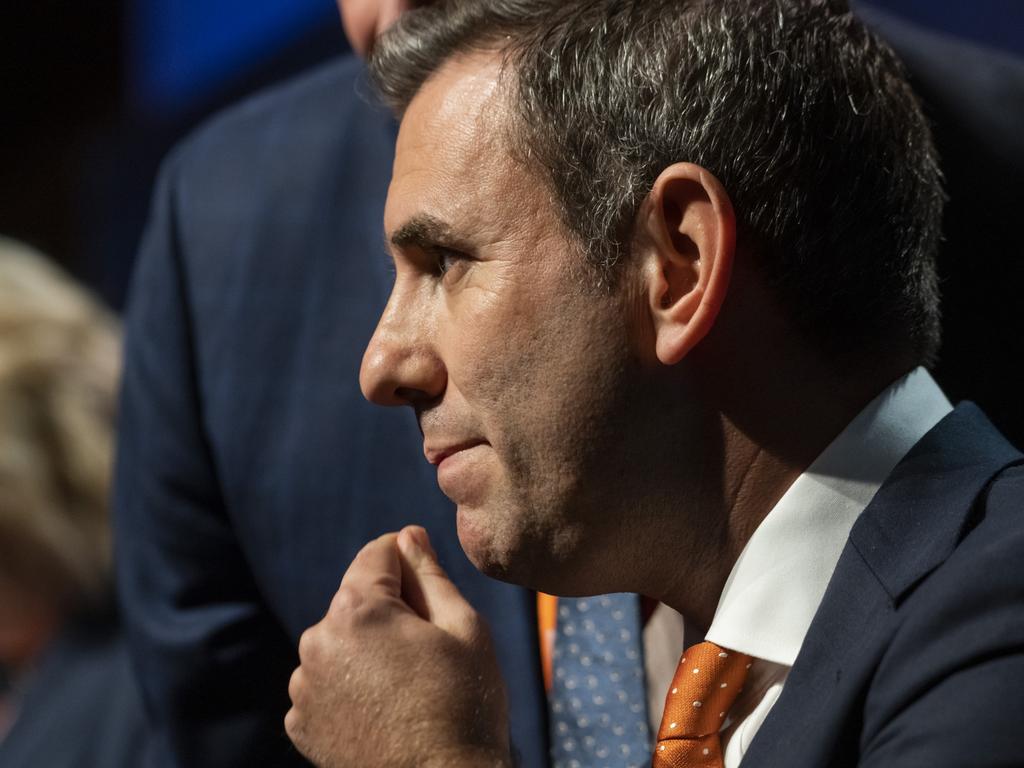Anthony Albanese’s bid to rein in growth of runaway disability scheme
A national cabinet deal to halve the growth rate of the NDIS in just three years must tighten access and slash payments to disabled Australians to stop costs blowing out, experts warn.

A national cabinet deal to halve the growth rate of the National Disability Insurance Scheme in just three years must tighten access and slash payments to disabled Australians to stop costs blowing out to nearly $100bn within a decade, top economists and disability experts warn.
Anthony Albanese on Friday unveiled a tough new “financial sustainability framework” alongside state and territory leaders, declaring “the trajectory of NDIS expenditure is just not sustainable into the future”.
In a slew of national cabinet announcements before the May 9 budget, the Prime Minister warned that, without intervention, the NDIS could find itself in a situation “where the viability of what is a critical scheme for Australia is drawn into question”.
“That trajectory projects some $97bn on the NDIS over the medium term, so, in 10 years’ time, when you look at the budget framework, that is simply not sustainable,” Mr Albanese said.
“We want to make sure that the promise of the NDIS is fulfilled. We want to make sure that the commonwealth can work with the NDIA board to take immediate action to ensure a sustainable scheme.”
National cabinet’s move prompted disability advocates to accuse the government of breaking its promise not to impose caps on the scheme.
Every Australian Counts chair George Taleporos said: “People with disabilities and families around the country will be feeling very anxious about what this means. This sounds like a cap on the NDIS, which is something the government promised they would not do.
“The government and the community needs to understand that the NDIS is an investment, not a frivolous expense.
“It provides life-saving and life-changing supports that are essential for Australians with disabilities to live a good life in the community.”
The plan to curtail the growth of the NDIS was announced as national cabinet also agreed to a $2.2bn overhaul of Medicare designed to bolster general practice, expand the suite of healthcare workers in primary care and co-ordinate preventive care to address the growing crisis of overwhelmed hospitals.
National cabinet – dominated by Labor federal and state leaders after the NSW election in March, with Tasmania’s Jeremy Rockliff the only Liberal in the group – also pushed forward with plans to increase social housing and “renters’ rights”.
The budget last October showed the NDIS was predicted to grow at an average annual rate of 15 per cent a year, with the total cost ballooning from $29.9bn in 2021-22 to $51.8bn by 2025-26.
In order to rein in spending on the scheme, the government revealed a $720m package in next month’s budget that would lift the NDIA’s “capacity and capability” in assessing existing and prospective participants.
NDIS Minister Bill Shorten said the investment would fund 10 key initiatives that had been developed in consultation with the NDIS review co-chairs, including less frequent plan reviews to prevent unnecessary labour for staff and anxiety for participants.
The government will also give participants a list of “preferred providers”, which will not include those found to be price-gouging, in order to get the price of services and equipment charged to NDIS participants back under control.
“We are going to improve how the scheme works for participants, their families and the people who work in the disability sector,” Mr Shorten said. “These reforms are about ensuring the future of the scheme in the best interests of the participants.”
The $720m package will also “better support participants to manage their plan within budget”, which will include assistance from NDIA staff to help hold participants’ providers and support co-ordinators to account.
NDIS review co-chairs Bruce Bonyhady and Lisa Paul helped develop the 10 initiatives and will report to government with further recommendations on improving the scheme by the end of the year.
While the government is quietly confident the $720m reboot of the scheme will on its own reduce the NDIS’s annual growth to 8 per cent by 2026, People Economics director Hassan Noura said achieving the target required “fundamental change”.
“Slowing the rate of growth by half is going to be huge, and it’s going to be really, really hard,” said Mr Noura, a former head of strategy at the NDIA. “The reality is that, even if there is no growth in the number of people on the NDIS, and you keep it at about 600,000, the cost of the plans are increasing at 10 per cent per year on average – that’s already more than 8 per cent.
“It’s going to require action on both eligibility and on the cost-per-person side in order to meet that target and there still hasn’t been any indication from the government on meaningful ideas on either of those two categories.”
Martin Laverty – an NDIS board director who oversaw the start of the scheme – said the 8 per cent target had been set by the government to “keep the confidence of the taxpayer”, but that doing so would require tightening eligibility.
“Revisiting eligibility is essential to bringing scheme costs back in line,” Dr Laverty said.
People With Disability Australia president Nicole Lee said the eligibility requirements were difficult enough and cautioned against any raising of the bar. “It’s not like it’s an easy thing to get onto the NDIS,” she said. “It’s already pretty complicated and tight to gain access to the scheme. So I think it would be a bit of a backward step to … tighten that even further.”
Dr Laverty said the NDIS had allowed states to “vacate the field” in supporting those with disabilities and premiers needed to come back to the table. “This requires work across the health sector, the education sector, the early childhood sector, the aged care sector, to get the NDIS working in the way that it was intended,” he said.
From an equal federal-state share of 50-50, the commonwealth contributes 66 per cent of the NDIS cost and Mr Albanese said the share of federal spending was expected to jump to 82 per cent in a decade. However, Mr Albanese said he was not proposing to change the current cost-sharing arrangement.







To join the conversation, please log in. Don't have an account? Register
Join the conversation, you are commenting as Logout